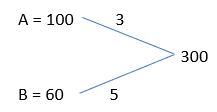Question
Quantity I : Number of days the work is extended beyond
normal days. A can do a piece of work in 100 days and B in 60 days. Both of them start working together and 6 days before the scheduled completion, B drops out. Quantity II : Number of days required to complete the work working 10 hrs daily by 60 women working together. 24 men take 20 days working 12 hrs daily to do a piece of work, if 5 women do as much work as 4 men.Solution
Quantity I:  Both can complete the work in 300/8 = 37.5 days Work done in (37.5 – 6) days = 31.5 × 8 = 252 unit Remaining work = 300 – 252 = 48 unit After B drops out remaining part will be completed by A in = 48/3 = 16 days Total time taken = 31.5 + 16 = 47.5 days Actual time taken = 37.5 days Difference = 47.5 – 37.5 = 10 days Quantity II: 5W = 4M 1W = (4/5) M Let the no. of days required to complete the work is D. 10 × 60W × D = 24M × 20 × 12 10 × (60×4)/5 M × D = 24M × 20 × 12 D= 12 days Hence, Quantity I < Quantity II .
Both can complete the work in 300/8 = 37.5 days Work done in (37.5 – 6) days = 31.5 × 8 = 252 unit Remaining work = 300 – 252 = 48 unit After B drops out remaining part will be completed by A in = 48/3 = 16 days Total time taken = 31.5 + 16 = 47.5 days Actual time taken = 37.5 days Difference = 47.5 – 37.5 = 10 days Quantity II: 5W = 4M 1W = (4/5) M Let the no. of days required to complete the work is D. 10 × 60W × D = 24M × 20 × 12 10 × (60×4)/5 M × D = 24M × 20 × 12 D= 12 days Hence, Quantity I < Quantity II .
Quantity-I: 'E' can do 40% of work in 32 hours. Find the value of 'Y' if the time taken by him to complete the whole work is 'Y' hours.
Quantit...
If (y/5) = 11/(z+1).
Value of 'y' is root of p2 - 10p + 25 = 0.
Quantity I: Value of 10z.
Quantity II: 100
...Quantity-I: ‘A’ and ‘B’ started a business by investing Rs. ‘x’ and Rs. 3,200, respectively. ‘A’ and ‘B’ invested their sum for 6 m...
The current ages of three friends, Aman, Bheema, and Chintu, are represented as (p−3), p, and (2p−6) years, respectively. It ...
The ratio of present ages of A and B is 5:8 respectively and the average of present ages of A and C is equal to 80% of the present age of B. 4 years ago...
Quantity I: A student multiplied a number by 3/5 instead of 5/3 . What is the % error in the calculation?
Quantity II: The population of a town i...
In the question, four Quantity I, Quantity II, Quantity III, and Quantity IV are given. You have to solve all the four Quantities and establish the corr...
In the following question, read the given statement and compare Quantity I and Quantity II on its basis. (Only quantity is to be considered)
Quantity 1: A piece of land is 50 m long and 30 m wide. If it is sold for ₹200 per square meter, what will be the total sale price?
Quantity 2:...
Quantity I. A sum of money becomes tripple in 4 years at compound interest, compounded annually. In how many years it will become 9 times?
Quanti...
Relevant for Exams:


